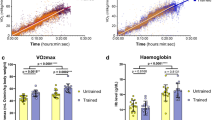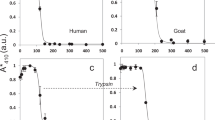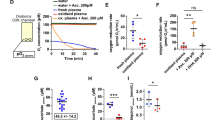Abstract
THERE are three stages in the development of human haemoglobins. In the smallest embryos studied the embryonic haemoglobins, Hb-Gower 1, Hb-Gower 2 and Hb-Portland are the main haemoblobins found1, but foetal haemoglobin (Hb-F) is also present in gradually increasing amounts. By about the 30 mm (crown–rump (CR) length) stage, Hb-F amounts to about 50% of total haemoglobin and after 50 mm it forms over 90% of total pigment. Adult haemoglobin (Hb-A) is already present by week 8 of gestation but this does not exceed 10% of total haemoglobin until week 30; after this it gradually increases until at term it forms between 10% and 30%. After birth, Hb-F is rapidly replaced by Hb-A and at 6 months Hb-F is less than 10%, while at one year it forms less than 2% of total haemoglobins. The oxygen dissociation properties of adult haemoglobin and of foetal haemoglobin have been studied in great detail. Foetal blood has a higher oxygen affinity than adult blood; this helps the transport of oxygen across the placenta and ensures that the steep part of the oxygen dissociation curve corresponds to foetal tissue oxygen tensions, thus maximising the release of oxygen. The oxygen affinities of the human embryonic haemoglobins have so far not been studied because the amounts available have been extremely small. Here we describe the oxygen dissociation properties of human embryonic red cells which were found to be similar to those of foetal red cells.
This is a preview of subscription content, access via your institution
Access options
Subscribe to this journal
Receive 51 print issues and online access
$199.00 per year
only $3.90 per issue
Buy this article
- Purchase on Springer Link
- Instant access to full article PDF
Prices may be subject to local taxes which are calculated during checkout
Similar content being viewed by others
References
Huehns, E. R., and Beaven, G. H., Clinics in Developmental Medicine, 37, 175 (1971).
Bellingham, A. J., and Huehns, E. R., Nature, 218, 924 (1968).
Benesch, R., Macduff, G., and Benesch, R. F., Analyt. Biochem., 11, 81 (1965).
Huehns, E. R. et al. Nature, 201, 1095 (1964).
Capp, G. L., Rigas, D. A., and Jones, R. T., Science, 117, 65 (1967).
Todd, D., Lai, M. C. S., Beaven, G. H., and Huehns, E. R., J. Haemat., 19, 27 (1970).
Huehns, E. R. in Blood and its Disorders (edit. by Hardisty, R. M., and Weatherall D. J.), 561 (Blackwell, Oxford, 1974).
Capp, G. L., Rigas, D. A., and Jones, R. T., Nature, 288, 278 (1970).
Dayhoff, M. O. Atlas of Protein Sequence and Structure (National Biomedical Research Foundation, Silver Spring, 1970).
Clegg et al. Nature, 251, 247 (1974).
Author information
Authors and Affiliations
Rights and permissions
About this article
Cite this article
HUEHNS, E., FAROOQUI, A. Oxygen dissociation properties of human embryonic red cells. Nature 254, 335–337 (1975). https://doi.org/10.1038/254335a0
Received:
Revised:
Issue Date:
DOI: https://doi.org/10.1038/254335a0
This article is cited by
-
Generation of erythroid cells from polyploid giant cancer cells: re-thinking about tumor blood supply
Journal of Cancer Research and Clinical Oncology (2018)
-
Human embryonic haemoglobins Gower 1 and Gower 2
Nature (1979)
-
Haemoglobin-oxygen affinity in developing embryonic erythroid cells of the mouse
Journal of Comparative Physiology ? B (1979)
-
Embryonic hemoglobins: dependency of functional characteristics on tetramer composition
Pfl�gers Archiv European Journal of Physiology (1978)
-
Oxygen affinity and phosphate compounds of red blood cells during intrauterine development of rabbits
Pfl�gers Archiv European Journal of Physiology (1977)
Comments
By submitting a comment you agree to abide by our Terms and Community Guidelines. If you find something abusive or that does not comply with our terms or guidelines please flag it as inappropriate.



